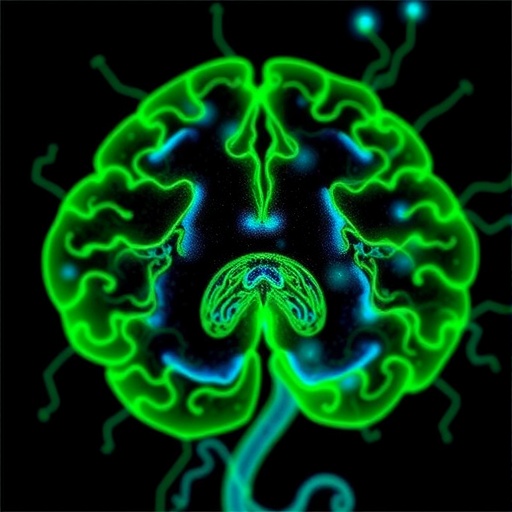New research by Kiersnowski et al. dives deep into the realm of neurodegeneration, particularly focusing on alpha-synucleinopathies, a group of disorders primarily characterized by aggregation of the protein alpha-synuclein. These include Parkinson’s disease, dementia with Lewy bodies, and multiple system atrophy. As the understanding of these diseases evolves, the importance of identifying specific biochemical markers becomes paramount. This study explores the role of magnetic susceptibility as a potential diagnostic tool in distinguishing different forms of neurodegeneration within these disorders.
The use of magnetic resonance imaging (MRI) has transformed our ability to visualize and understand brain pathology. However, traditional imaging methods often lack the ability to capture subtle variations indicative of specific neurodegenerative processes. Kiersnowski and colleagues propose that magnetic susceptibility measurements provide a novel layer of insight into the complex and heterogeneous nature of alpha-synucleinopathies. This innovative approach holds promise in improving diagnostic accuracy and ultimately patient outcomes.
One of the most significant aspects of this study is the introduction of magnetic susceptibility as a key metric in evaluating neurodegenerative diseases. Magnetic susceptibility refers to the degree to which a material can be magnetized in an external magnetic field and varies significantly across different brain tissues and pathological states. By employing a range of imaging techniques, the research team was able to quantify the magnetic susceptibility of various brain regions impacted by alpha-synucleinopathies.
Their findings indicate that there are distinct patterns of magnetic susceptibility associated with each neurodegenerative condition. For example, patients with Parkinson’s disease exhibited unique susceptibility profiles compared to those with dementia with Lewy bodies. This differentiation is crucial, as it could help tailor treatment strategies more effectively to individual patients, potentially leading to better management of their conditions. Furthermore, the study emphasizes the importance of understanding the pathological mechanisms underlying these conditions, as this knowledge can guide future therapeutic developments.
Moreover, the research highlights the significant potential of integrating magnetic susceptibility metrics alongside other imaging modalities. By adopting a multimodal imaging approach, clinicians could enhance their diagnostic capabilities. For instance, combining magnetic susceptibility data with conventional MRI and positron emission tomography (PET) imaging might yield richer insights into the metabolic and structural changes occurring in the brain during neurodegeneration.
The implications of this study extend beyond mere academic curiosity. The increasing prevalence of neurodegenerative diseases worldwide underscores the urgency of developing better diagnostic tools. With millions affected by conditions such as Parkinson’s disease, the need for early detection and intervention cannot be overstated. Kiersnowski and team’s approach could pave the way for breakthroughs in how these diseases are diagnosed and managed, shifting the paradigm toward proactive care.
Additionally, the role of alpha-synuclein in neurodegeneration itself offers fertile ground for further exploration. This protein has been implicated in various cellular processes, and its aggregation is a hallmark of the disorders studied. Understanding the factors that lead to the misfolding and accumulation of alpha-synuclein could unlock new therapeutic avenues. Investigating how magnetic susceptibility changes correlate with alpha-synuclein pathology could provide further insights into the disease mechanisms at play.
The study also raises pertinent questions about the interplay between genetic predispositions and environmental factors in these diseases. As research elucidates the multifactorial nature of neurodegeneration, the identification of specific susceptibility profiles may allow for personalized risk assessments. This would enable healthcare providers to make informed decisions regarding monitoring and interventions tailored to individual risk profiles.
In addition to clinical implications, the research contributes to a larger conversation on the integration of advanced imaging techniques in neuroscientific research. As technology evolves, the ability to visualize biological processes at unprecedented resolutions opens new avenues for discovery. Magnetic susceptibility imaging serves as a compelling example of how interdisciplinary approaches can enhance our understanding of complex neurological conditions.
Importantly, this study invites further validation and research within diverse populations. As neurodegenerative diseases can manifest differently across cultures and genetic backgrounds, expanding the scope of this research could provide robustness to the findings. Establishing a wide-ranging database of magnetic susceptibility profiles associated with alpha-synucleinopathies would be invaluable for future studies.
As we look to the future, the intersection of neuroscience, imaging technology, and precision medicine represents one of the most promising frontiers in healthcare. Kiersnowski et al.’s work embodies this potential, illuminating pathways to more effective patient care. By harnessing the insights gained from magnetic susceptibility measurements, the medical community can strive toward more accurate diagnoses, informed treatment decisions, and ultimately, improved quality of life for individuals grappling with these challenging diseases.
As further studies build upon this foundation, the hope is that the nuanced understanding of alpha-synucleinopathies will enhance research collaborations across disciplines. From basic science to clinical applications, the integration of innovative imaging techniques could be transformative. The promise of magnetic susceptibility as a diagnostic tool opens doors for exciting developments in the realm of neurodegeneration, reinforcing the notion that through science, we can make significant strides in combating complex disorders that afflict millions globally.
In conclusion, Kiersnowski et al.’s research marks a significant advance in our understanding of alpha-synucleinopathies, emphasizing the potential of magnetic susceptibility as a groundbreaking diagnostic tool. As researchers and clinicians unite to capitalize on these findings, the potential for enhanced patient outcomes becomes a tangible goal. This important study not only sheds light on the intricate nature of neurodegenerative diseases but serves as a clarion call to continue exploring the vast possibilities that lie ahead in neurological research.
Subject of Research: Neurodegeneration in alpha-synucleinopathies
Article Title: Correction: Magnetic susceptibility components reveal different aspects of neurodegeneration in alpha-synucleinopathies.
Article References:
Kiersnowski, O.C., Mattioli, P., Argenti, L. et al. Correction: Magnetic susceptibility components reveal different aspects of neurodegeneration in alpha-synucleinopathies.
Sci Rep 15, 36306 (2025). https://doi.org/10.1038/s41598-025-23734-0
Image Credits: AI Generated
DOI: 10.1038/s41598-025-23734-0
Keywords: Magnetic susceptibility, neurodegeneration, alpha-synucleinopathy, Parkinson’s disease, dementia with Lewy bodies, MRI, imaging techniques, biomarkers.




